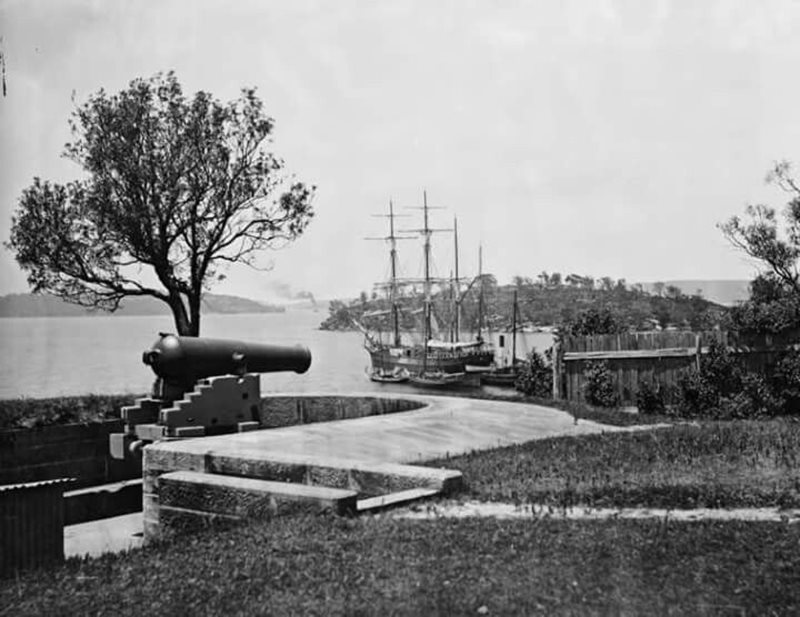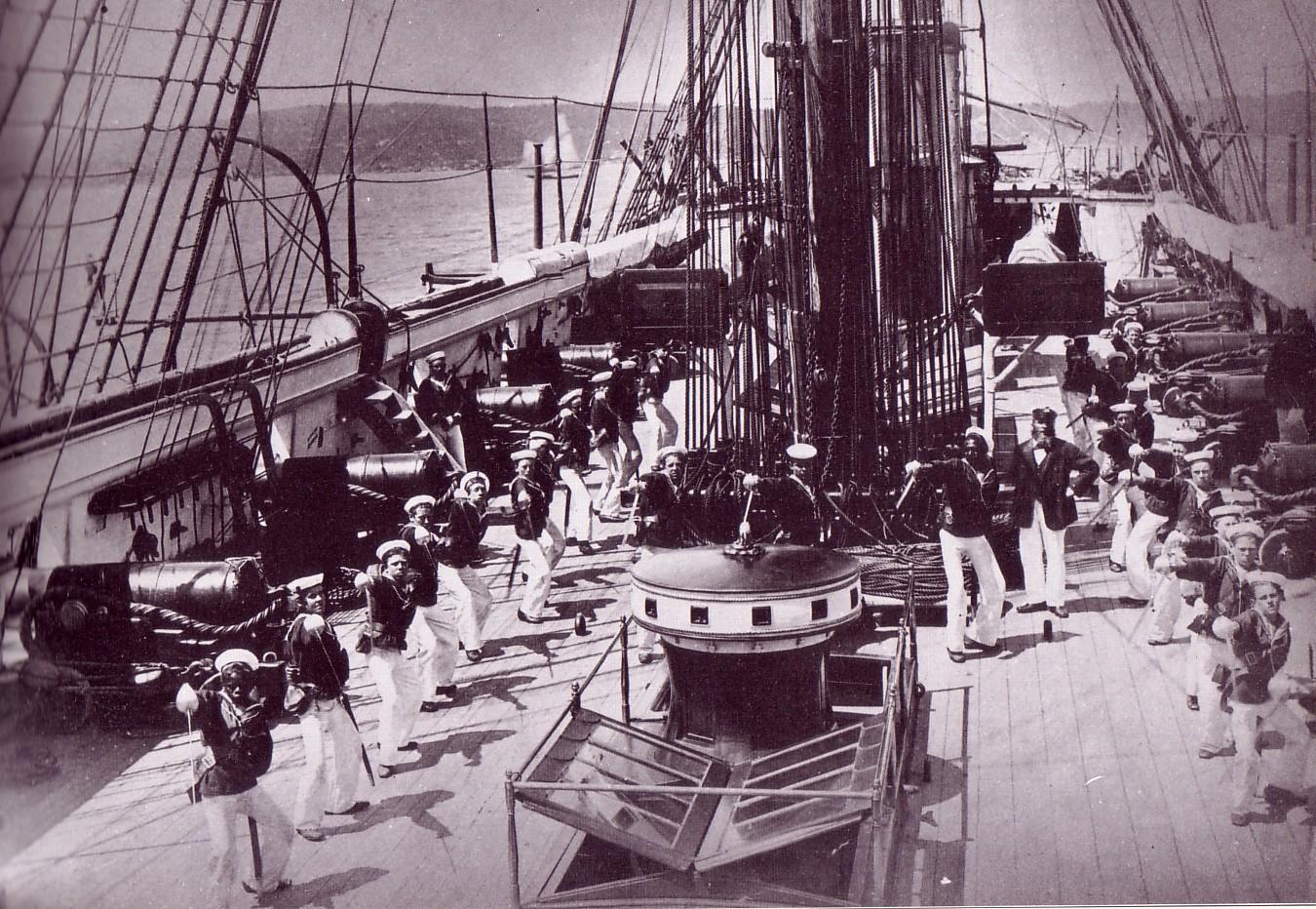- Author
- A.N. Other
- Subjects
- History - pre-Federation
- Tags
-
- RAN Ships
- None noted.
- Publication
- March 2023 edition of the Naval Historical Review (all rights reserved)
By Colin Randall
Many Australian harbours are defended against enemy attack and none more so than Sydney, which has had shore-based fortifications since the days of the First Fleet. Potential threats have been aplenty from France, Germany, Japan, Russia, Spain, and even the United States, it just depends on where you look along the timeline, and by now we might add China. But in terms of realistic threats these did not arrive until 31 May 1942 when Japanese midget submarines attacked Sydney Harbour, followed by a bombardment of Sydney and Newcastle by the parent submarines. In addition, German ships laid mines in our coastal waters in November 1940, and from February 1942 to November 1943 ships off our coast were torpedoed by the Japanese, who also bombed Broome, Cairns, Darwin, Townsville and Wyndham.
So other than build fortifications what did we do to ensure that these defences were sufficient for our needs? Mock invasions and defence exercises were conducted with vigour against those who would dare assault our shores. There is a report in the local newspapers of possibly the largest and most advanced of these exercises occurring in Sydney on 12 April 1881. While this is in the rather florid language of those times, we were lucky to find a later document ‘The Battle of Macquarie Point’ written by Bruce Harding1 in 1947. With the addition of a few photographs taken from newspapers of those times the attached story is mainly from Bruce Harding’s description.
A Call to Arms and a Public Holiday
The morning press in Sydney on Tuesday 12 April 1881 carried an unusual number of government advertisements calling on members of the Naval Brigade to parade at specified times in full uniform and complete with arms. Nearby was almost another column of announcements offering for hire all manner of boats. The day itself had been declared a public holiday; the city pulsed with excitement.
Sydney’s citizens had been officially invited to witness something hitherto only seen in England – a mock naval invasion complete with all the trimmings. Mrs Macquarie’s Chair was the point for whose possession the contending parties would struggle.
Blue, cloudless skies, warm sunshine and a pleasant breeze greeted the people as they began to stream to vantage points in the Domain, the Botanical Gardens and Fort Macquarie. The harbour was dotted with well-filled hire boats, whose owners had promised an excellent view of the proceedings. By noon fifty thousand people had gathered. Police said that it was the greatest crowd ever gathered in Sydney.

National Library of Australia.
The Masked Battery
The headland at Mrs Macquarie’s Point also had strategic value in the defence of Sydney Harbour. The first example of its military use was a response to the fears of foreign invasion during the Crimean War (1853-1856). In 1856 Mrs Macquarie’s Point was equipped with a ‘masked battery’ of eight artillery pieces. These were arranged above and behind Mrs Macquarie’s Chair. The battery was composed of a rammed earth and concrete defilade (wall) fitted with embrasures.
It was commonly referred to as ‘the little fort’, usually in association with Mrs Macquarie’s Point. By 1870, the concern over foreign invasion had all but dissipated and the guns were removed. An archaeological excavation and subsequent report were undertaken in 1989 on the Masked Battery, after which it was promptly buried again to preserve the site.
The Fortifications and Defenders
On the occasion in 1881 Mrs Macquarie’s Point was again strongly fortified. On the little tableland were mounted eleven guns. The Naval Brigade handled three 9-pounders and three howitzers; HMS Wolverine supplied a forward gun and a Gatling gun with crews, HMS Emerald the same and HMS Miranda, a Gatling gun. The dark colour of the guns blended with the foliage, but the location of each gun site could be easily determined by watching for clusters of men and flashes of scarlet, blue and white uniforms. This unintentional revealing of gun sites, however, was considered to add further variety to the scene.
The Invaders
Everything was ready. All eyes were on the ‘invading squadron’ which had steamed up harbour during the morning and treated the crowd to a special display of formation sailing and manoeuvring. The ships were now lying at anchor offshore, while the crews and official guests aboard lunched. Commanded by Commodore John Crawford Wilson from his flagship Wolverine, the squadron consisted of Wolverine with 17 guns and 335 men; Emerald with 13 guns and 230 men; Alertwith 17 guns and 220 men; Miranda with six guns and 145 men; Cormorant with six guns and 145 men; Alacrity with one gun and 35 men; Beagle, Conflict, Sandfly, and Renard with one gun and 30 men each. There were also 330 men of the Naval Brigade. Thus about 1560 men – of whom 400 were defenders – were to take part in the operation.
Aboard the flagship a happy gathering of ladies and gentlemen were guests of Commodore Wilson; amongst them, His Excellency the Governor, Lord Augustus Loftus, GCB, and Sir Henry Parkes, KCMG, with most other dignitaries of the day.
Then at twenty minutes past twelve, Commodore Wilson gave an order; a shot from one of Wolverine’s guns rang out, and the battle commenced. To the other ships Wilson signalled: ‘Commence firing your guns’. The naval crews needed no encouragement. Every gun that could bear was aimed and fired again and again. The spellbound crowd saw stabs of flame followed by puffs of fleecy white smoke which drifted lazily away, sunbeams striking through it to cast bronze shadows on the water.
The Shore Garrison
The shore garrison was equally active. When the warning shot was heard, Captain Maclear RN shouted an order. Themen jumped to their guns and manned them with skill and precision. The noise was deafening. Salvo for salvo; shot for shot; the cheeky clatter of rifles – all helped in this conglomeration of noise. Ladies covered their ears and closed their eyes. Intrepid official artists shifted position to obtain sketches, heedless of the withering fire.

The naval bombardment grew heavier and soon the land troops received an order to retreat to cover. This they did and every tree in the vicinity became the shelter for nearly twenty men. The lee side of every hillock had its occupant. Through the smoke it was sometimes possible to catch a glimpse of the men as they flitted from one shelter to another.
Landing Parties
Then as the fire of Wolverine, Cormorant, Emerald and Miranda slackened, watchers saw the landing parties man their boats. Heavy covering fire broke out again as the crowded boats dashed shorewards.
From the shore came an angry fire, but the boats grounded safely and planks were run out for disembarkation. The occupants, however, were excited and anxious to come to grips with the opposing force, so most of them leapt into the water and waded ashore. They were eagerly met by the shore party. Both attackers and attacked could be seen darting about. Sometimes the invaders would sweep part of the way up the ascent, only to be driven back to the beach by the well-organised defenders.
At last, under orders from their commander, Captain Maxwell, they withdrew in some disorder to their boats, clambered aboard as best they could and pulled away, ‘tormented by more withering volleys’, as some chronicles had it.
Watching this, Wilson decided to go all out for victory and immediately brought down such a concentrated bombardment that the shore guns were silenced. Dragging the guns out of the way, the defenders prepared to repulse another assault on the point.
It came shortly afterwards with 120 men in three well-manned boats, behind which two steam cutters towed launches filled with marines, looking just like those seen in pictures in the illustrated London papers.
Again the defenders lined the shore. But the attacking force, fresh and thoroughly determined to succeed, soon proved too strong. The land force, although fighting desperately for every inch of the way, was slowly driven back until about 3.30 pm, when both forces passed certain boundary marks which denoted that the invaders were victorious.

Cease Fire
The ‘cease fire’ was sounded and the noise of battle died away. The opposing forces became friends again; Wilson smiled his satisfaction; feminine pulses returned to normal. The battlefield was immediately overrun with small boys delightedly searching for empty cartridge cases and the grimy participants were lined up in their respective companies. As a finale the crowd was then treated to a splendid display of marching and drill as the men started off for Circular Quay to the accompaniment of brass bands. The spectators cheered and admired the bearing of the troops.
Anti-climax came too – in the form of a bewildered cow which somehow got mixed up in the line. Suddenly placed in such exceptional circumstances, she took courage and made for a section of the crowd which politely gave her a clear passage. Beyond frightening a few timid people, reports stated, she did no damage and no doubt found her way home.
Late in the afternoon the men reached the Quay where the Naval Brigade were dismissed and the seaman embarked on their respective ships.
‘Commodore Wilson gave us more than a show’, declared an editorial next day. ‘He gave us a lesson. The moral is that at all costs we must keep an enemy out, and if that idea is fixed firmly in the minds of legislators, the powder that was burnt yesterday was blazed away to good advantage’.
Although only powder and blank cartridges were used, it was generally agreed that not until battle raged in reality, would the Point present so warlike an aspect as it did during the bloodless invasion.
Battle did rage one night during a submarine attack on Sydney in May 1942. But the invaders were defeated.
Notes
1 Bruce Alfred Harding (1920-2003) was a military historian who served as a Lieutenant with the Second AIF during WWII.
References
Harding, B. A., The Battle of Macquarie Point, published in As You Were: A Cavalcade of Events with the Australian Services from 1788 to 1947, Australian War Memorial, Canberra, 1947.
Illustrated Sydney News and New South Wales Agriculturalist and Grazier, Saturday 23 April 1881, p 21.
Sydney Mail, Wednesday 3 July 1929, page 21 – Reporting on event forty-eight years previously.
A Point in History – The Royal Botanic Garden Sydney https://www.rbgsyd.nsw.gov.au › stories, Dec 2022.




